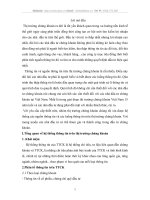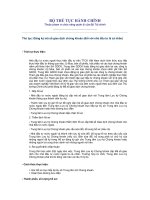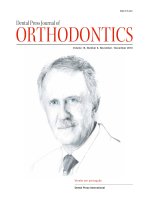Dental analogies đối thoại nha khoa
Bạn đang xem bản rút gọn của tài liệu. Xem và tải ngay bản đầy đủ của tài liệu tại đây (335.84 KB, 243 trang )
Copyright © 2013 Dr. Rick Waters
This material is protected under the
copyright laws of the United States of
America. All rights are reserved. No
part of this book may be reproduced,
stored in mechanical or electronic
retrieval systems, or transcribed in
any way by any means without the
prior, written consent of the authors,
except where allowed by law or for
the creation of any recordings or
other material intended for use by the
blind.
International Standard Book Number
0-96-422800-9
INTRODUCTION
Success in any profession, dentistry
included, depends on the
development of many skills. These
include clinical and technical, business
and organizational, communicative
skills, and others. A practicing dentist
uses any number of these attributes
every working day.
Clinical mastery comes as the result of
an adequate professional education,
both through dental schooling and
post-graduate continuing education.
Business and organizational skills,
following a rather shallow
introduction in dental school, are
developed experientially and through
continuing education. The
communication skills, cited as among
the most important, have traditionally
been slighted. As such, the palette of
resources from which to choose to
better one's communication abilities
is small. This book was written to
affect, profoundly and favorably, the
communication skills of the dentist
and dental team members.
Few would argue the premise that
dental treatment should never be
delivered to a patient without that
patient's willful consent. In proper
legal, ethical, and moral
considerations, that patient's
informed consent must be based on a
thorough knowledge of the facts — of
the pluses and minuses of both
treatment and non-treatment.
Autonomy in dental care helps the
patient realize dental self-
actualization according to particular
needs and desires. Unfortunately,
some presenters are unable to
adequately introduce the necessary
treatment plan in a way that creates
true desire by the patient. With often
only a single chance to make this
presentation to a patient, this
miscommunication may cause the
dentist to miss out completely on the
opportunity to provide the
appropriate care for that particular
patient. Thus, the importance of the
treatment plan presentation cannot
be overemphasized.
The treatment plan presentation is
simply an organized presentation of
dental needs and a plan or plans for
solutions to answer those needs. It is
akin to a sales presentation which, on
its highest level, concentrates in
finding a particular need and filling
that need. Sales presentations can be
about intangibles, like insurance, or
something more substantive, like the
delivery of dentistry. The selling of the
item is simply the formal process by
which needs are determined,
communicated to the client or
patient, and filled.
Unfortunately, many dentists find the
idea of selling "raw," to a degree.
Nonetheless, the fact remains:
practically every successful person in
his or her chosen profession proposes
a service, idea, or product believing it
will make the client’s life better. For
example, the primary goals in
healthcare are to properly provide for
patient needs and to promote health
and well-being.
To meet those ends, adequate patient
education is mandatory. Deviation
from properly presenting alternatives
is especially disserving in healthcare
situations. Certainly, failure in the
ultimate goal of helping the patient
achieve dental self-actualization
through autonomy is a worse ill than
any act of selling.
Dentistry well-deserves the accolades
bestowed upon it for its successes in
preventive care and attending to
patient needs in a timely, cost-
effective, and honorable manner.
Now, more is being demanded of the
dentist, both from within the medico-
legal arena and from patients
themselves. Most patients want to be
involved in treatment planning and it
is the dentist's responsibility to be
certain that each patient understands
the thinking behind the doctor's
proposed treatments.
In order for informed consent to work,
the patient must have a crystallized
mental image about his or her
problem(s) and the proposed
solution(s). To do this, dentists
traditionally use brochures, diagrams,
and models to educate patients.
Unless these teaching tools can be
sent home with the patient, residual
effects are short-lived. Even when
they ARE provided to the patient,
they can get lost and even destroyed.
More modern educational means,
including multimedia and the use of
the intraoral camera, can bring the
patient to an even higher level of
understanding. However, it still may
not be any longer lasting than that
achieved by using the aforementioned
tangible means. In addition, calling to
attention one's own periodontal
disease or broken tooth via an
intraoral camera and 42-inch LCD
monitor does not automatically create
a want for treatment within that
patient; rather, if not properly
managed it may embarrass or, even
worse, sell the patient on the service
without emphasizing its implicit value.
Such a "sale" does little to serve the
patient properly and may even
condemn the "service" to imminent
failure.
What is a better way?
Every day, throughout the world,
there are many sales presentations
that result in the acceptance of things
valued at hundreds of thousands of
dollars and more. Of course, these
presentations occur outside dentistry.
Still, they do happen and the
purchase of the service or product
being presented is often predicated
on the acceptance of an idea alone. In
the business world, it is called "selling
the sizzle, not the steak." It is what
many dentists hope to do at every
treatment plan presentation. Sadly, it
often meets with failure. The more
clearly the patient understands the
need and the prescribed solution(s),
the better the chance of case
acceptance and post-treatment
satisfaction for both the patient and
the dentist.
The direct, one-to-one information
transfer between the minds of the
dentist and the patient is the
preferred communication method in
dentistry, operating on an almost
ethereal plane. "Modern" time
constraints, attributed to increased
paperwork and the like, make every
patient’s visit and what is said at that
visit even more valuable.
In order to "sell the sizzle, not the
steak," exact information must be
shared. When done properly, the
patient leaves with an indelible, yet
satisfying, mental image that may be
all it takes, either now or later, to
resell the patient on the need for the
prescribed care.
A strong means of information
transfer involves the use of
metaphors or analogies to help the
patient arrange his or her own
thoughts for maximum result. Note
this example about the power of the
human mind:
A wanderer in the old days of Egypt
came upon a young man who was
forever looking for a fast and easy way
to make more money. This young man
had done well for himself and was
now looking with even more fervor
and greed. The wanderer made an
offer to the lad. "I can sell this magic
lamp and secret formula, only once,
for 1000 gold coins and I guarantee
that, together, they can turn sand into
gold." Naturally, the young man was
interested. "You guarantee the
formula?" "Or your money is
returned." the wanderer countered.
The lad succumbed to the offer and
the deal was struck. "The only
condition that will make the formula
not work." added the wanderer as he
handed over the lamp and
incantation, "is if, while rubbing the
lamp, you happen to think of a
monkey with a red tail. Then, the
formula will not work."
Woe is this young man who will now
find it nearly impossible to not think
of a red-tailed monkey.
So strong is the human
communicative experience.
Most people cannot create and
deliver such clever narratives as that
scripted above. For them, a source of
descriptive stories to help make
points is needed. “Dental Analogies”
is the first book of that kind. It is a
collection of ingenious analogies
created from hundreds of ideas from
practicing dentists from across
America and presented in a very
useable format – including an
expansive index. These dentists are
using these analogies every day and
report that they do, indeed, work –
and work well.
As a reference, this book's analogies
provide the dentist and team
members many stories to share with
patients that successfully compare
various dental modalities to more
familiar laymen's situations.
Afterwards, the patient has a greater
understanding of the dental
condition.
Consider this example: A long-lost
dental patient may question the need
for comprehensive periodontal
therapies like root planing and
curettage, subgingival irrigation, and
even surgery, citing the absence of
significant symptoms. An analogy such
as that found on pages 80-81 can be
used. It compares the problem and its
solutions to a failure to provide
regular oil and filter changes for an
automobile (with the concomitant
expense and inconvenience of a major
engine overhaul, et cetera.) Thus, the
patient better understands why one
brief dental "cleaning" cannot undo
what years of neglect have caused.
Additionally, it does not point a finger
nor does it belittle the patient. It
simply redirects the patient's mind to
a more familiar problem that is better
understood and accepted.
Julian Jaynes, in The Origin of
Consciousness in the Breakdown of
the Bicameral Mind (Houghton Mifflin,
Co., Boston, 1976) wrote:
"Understanding a thing is to arrive at
a metaphor for that thing by
substituting something more familiar
to us. And the feeling of familiarity is
the feeling of understanding (authors'
emphasis)." A metaphor is a figure of
speech in which a word or phrase
literally denoting one kind of object or
idea is used in place of another,
suggesting a likeness or analogy
between them.
This book of analogies is helpful not
just for answering questions and
objections, but for anticipating them
as well. For example, before
presenting a case to a patient that
involves implants or several units of
crown and bridge, pages 92 through
114 could be referenced. From these
the financial coordinator or the
doctor could select analogies best-
suited to the particulars of that
patient's hobbies, occupation, and
other interests. Maximum
effectiveness is realized if the financial
coordinator or doctor has really
gotten to know the patient
personally.
One of dentistry's most respected
figures, Dr. Lindsey Pankey, once said,
"Never treat a stranger." He proposed
up to 22 separate questions that can
be used to get to know a patient
before initiating treatment (A
Philosophy of the Practice of
Dentistry, by Lindsey D. Pankey and
William J. Davis, Medical College
Press, Toledo, OH, 1987) Information
like this can be used to help select the
most appropriate analogies for a
treatment plan presentation.
Some dentists have integrated a study
of these analogies in their team
meetings and "huddles" – like an
Analogy of the Day. One doctor
reports excellent results educating his
staff this way.
Readers may find it helpful to first
review all of the analogies, noting the
topics, keywords, and the layout. The
extensive index in the back makes








